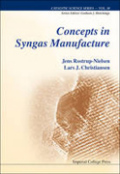
This book provides a general overview of syngas technologies as well as an in-depth analysis of the steam reforming process. Syngas is a mixture of hydrogen and carbon oxides which can be made from hydrocarbons, coal and biomass. It is an important intermediate in the chemical industry for manufacture of ammonia, methanol and other petrochemicals as well as hydrogen for refineries and fuel cells. Syngas is playing a growing role in the energy sector, because it can be converted into a number of important energy carriers and fuels. Syngas catalysis creates new options and flexibility in the complex energy network. The steam reforming process is the main technology today for manufacture of syngas. It is a complex intern-mingling of catalysis and heat transfer with restrictions caused by secondary phenomena such as carbon formation. Many of the principles are applicable for other gasification technologies of growing importance. Concepts of Syngas Preparation aims to provide a comprehensive introduction to this complex field of growing importance and gives a detailed analysis ofthe catalyst and process problems. This book also serves as an important linkbetween science and industry by illustrating how the basic principles can be applied to solve design issues and operational problems. INDICE: Basic Principles:Routes to Syngas: General trends; Manufacture by steam reforming of hydrocarbons; Other manufacture routes; Other feedstocks; Gas treatment; Syngas Applications: Thermodynamic framework for syngas processes; Hydrogen; Fuel cells; CO rich gases; Ammonia; Methanol and synfuels; Chemical recuperation; Steam Reforming Technology:Technology of Steam Reforming: Early developments; Steam reforming reactors; Modelling of steam reforming reactors; Modelling of the catalyst particle; Reaction kinetics; Catalyst Propertiesand Activity: Catalyst structure and stability; Nickel surface area; Catalystactivity; Carbon and Sulphur: Secondary phenomena; Carbon formation; Steam reforming of higher hydrocarbons; Sulphur poisoning of reforming reactions; Sulphur passivated reforming; Other poisons; Catalysis of Steam Reforming: Historical perspective; The role of step sites; Geometric or electronic effects; Metal activity. Micro-kinetics; The parallel approach.
- ISBN: 978-1-84816-567-0
- Editorial: Imperial College
- Encuadernacion: Cartoné
- Páginas: 392
- Fecha Publicación: 01/09/2011
- Nº Volúmenes: 1
- Idioma: Inglés
